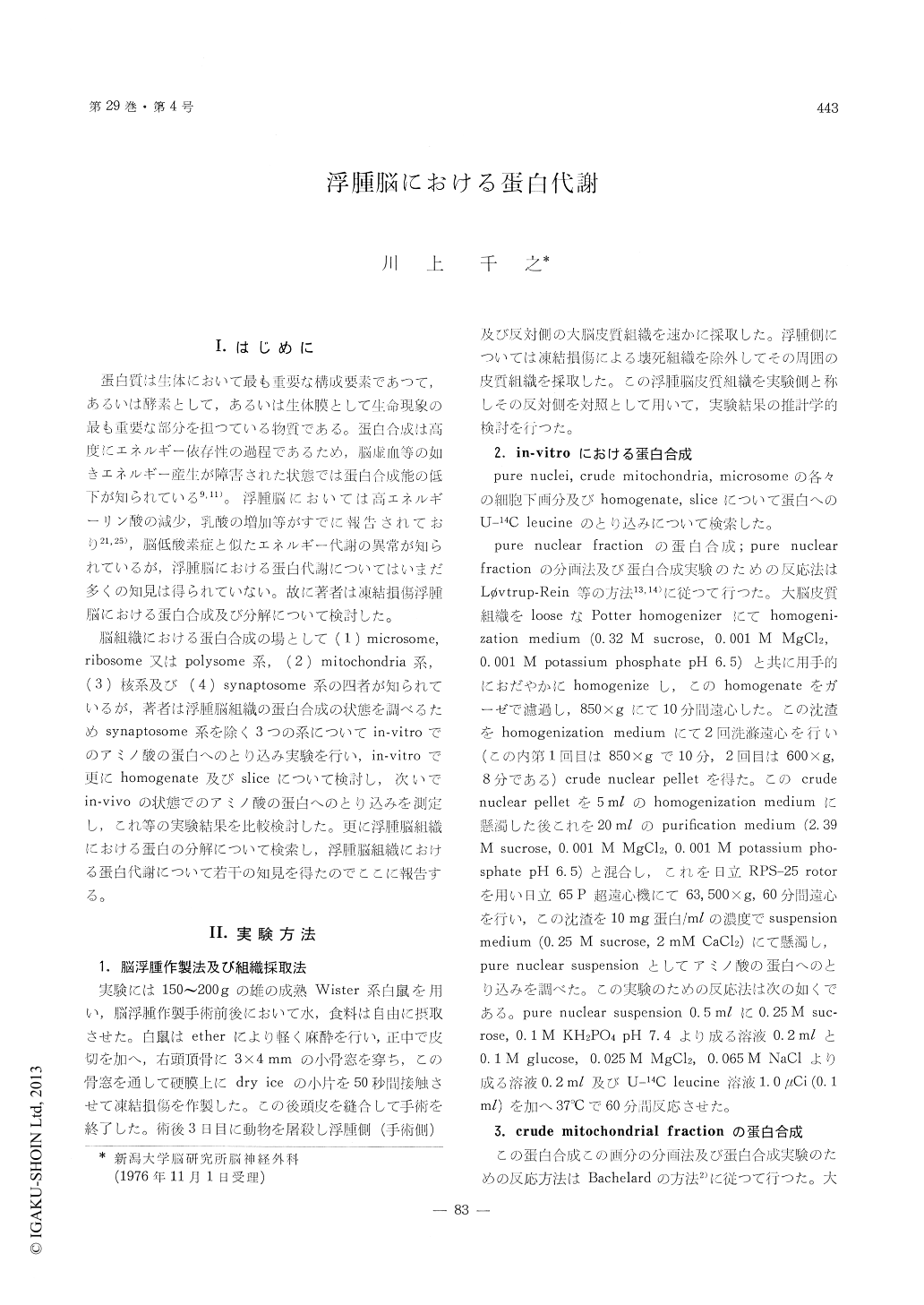Japanese
English
- 有料閲覧
- Abstract 文献概要
- 1ページ目 Look Inside
I.はじめに
蛋白質は生体において最も重要な構成要素であつて,あるいは酵素として,あるいは生体膜として生命現象の最も重要な部分を担つている物質である。蛋白合成は高度にエネルギー依存性の過程であるため,脳虚血等の如きエネルギー産生が障害された状態では蛋白合成能の低下が知られている9,11)。浮種脳においては高エネルギーリン酸の減少,乳酸の増加等がすでに報告されており21,25),脳低酸素症と似たエネルギー代謝の異常が知られているが,浮腫脳における蛋白代謝についてはいまだ多くの知見は得られていない。故に著者は凍結損傷浮腫脳における蛋白合成及び分解について検討した。
脳組織における蛋白合成の場として(1) microsome, ribosome又はpolysome系,(2) mitochondria系,(3)核系及び(4) synaptosome系の四者が知られているが,著者は浮腫脳組織の蛋白合成の状態を調べるためsynaptosome系を除く3つの系についてin-vitroでのアミノ酸の蛋白へのとり込み実験を行い,in-vitroで更にhomogenate及びsliceについて検討し,次いでin-vivoの状態でのアミノ酸の蛋白へのとり込みを測定し,これ等の実験結果を比較検討した。更に浮腫脳組織における蛋白の分解について検索し,浮腫脳組織における蛋白代謝について若干の知見を得たのでここに報告する。
Cold injury edema was induced in rats and in-corporation of radioactive amino acid into protein was investigated in-vivo and in-vitro. A small piece of dry ice was applied though a small opening of the skull upon the dura of a rat and the rat was killed on the third day of the operation to test the protein metabolism in edematous brain tissue. Results obtained from the edematous cerebral cortex were compared with those from the control (contra-lateral) cortex.
For the study of the in-vitro protein synthesis, amino acid incorporation into protein by pure nuclear, crude mitochondrial, microsomal system, and by slice, homogenates, crude nuclear fraction, post-nuclear fraction was studied. Pure nuclear fraction was obtained according to the method of Lφvtrup-Rein and protein synthesis was tested by the method of the same auther. No difference in the activity of protein synthesis was recognized between the nuclear fraction from the edematous and control cortex. Crude mitochondrial fraction was tested after the method of Bachelard. In-corporation of amino acid into protein by the mitochondria from the edematous cortex was about 30% lower than the incorporation by the control. The difference was however, statisticaly insignifi-cant. Activity of protein synthesis of the micro-somal system of the edematous brain tissue was tested according to the method of Mase et al. Cell sup fraction is indispensable for protein synthesis in the microsomal fraction. If one consider two kinds of sources of these fractions_ systems of fourdifferent kinds of combination of the microsome and the cell sup should be tested. The combinations of the microsome and the cell sup were as following; (1) both microsome and cell sup derived from the edematous cortex, (2) microsome from the edematous and the cell sup from the control cortex, (3) micro-some from the control and cell sup from the edematous cortex, (4) both microsome and cell sup from the control cortex. Among these four combi-nations combination-(1) showed the lowest incor-poration and the combination-(4) showed the highest. The difference between the value of the combination-(1) and values of other combinations was statisticaly signifficant. By all the results described above, any increase in protein synthesis in the edematous cerebral cortex was not shown, but decrease in in-vitro protein synthesis in the microsome of the edematous cerebral cortex was disclothed.
U-14C lysine was injected into the tail vein of the rat of the third day of the edema-inducing operation and the rat was sacrificed 30 min, 1 hour or 2 hours after the injection. The cortical tissue of the edematous and the control side were taken and the radioactivities in the acid soluble fraction and the protein was measured and relative specific activities of the protein was calculated. Although the specific radioactivity of the protein of the edematous cortex was a little bit higher than that of the control cortex, the relative specific activity of the protein of the edematous cortex was lower (however, statisticaly insignificant) than that of the control cortex, due to high uptake of amino acid into the edematous cortex which showed dis-turbance of the blood-brain barrier. Incorporation of U-14C leucine injected intraperitonealy into protein of the edematous cortex was not higher than that of the control. In-vivo incorporation of 4, 5-3H lysine into microsomal and cell sup protein was tested. 80μCi of the amino acid was injected into the tail vein of the rat 30 min before sacrifice on the third day of the edema-inducing operation and microsomal, cell sup and residual fractions were separated from the edematous and the control cortex. Incorporation of the amino acid into the microsomal protein of the edematous cortex was significantly lower than that of the control cortex.
Degradation of the protein was also tested. U-14C lysine was given a day before the edema-inducing operation and on the third day of the operation the rat was sacrificed and the residual counts in the protein of edematous and control cortex was measured. The results suggested that degradation of protein in the edematous cortex was suppresed.
From all the results described above, it was con-cluded that the protein synthesis in the edematous cerebral cortex was inhibited and the protein turn-over was also inhibited. It is possible that the inhibition in the protein synthesis is due to inhi-bition of the protein synthesis in the neuronal perikarya, because activity of protein synthesis in the neuronal perikarya is much higher than that in the neuropil (or glia).
The results derived from the experiments with homogenate and slice were in the contraly to the results described above. To solve this problem,difference in amino acid incorporation into protein of the edematous and the control cortex due to defferent condition of homogenization was tested, and experiments with crude nuclear and post-nuclear fractions were done. After these experiments, it was strongly suspected that the discrepancy in the results was due to special disturbance of the membrane function of the cell in the edematous brain tissue.

Copyright © 1977, Igaku-Shoin Ltd. All rights reserved.


